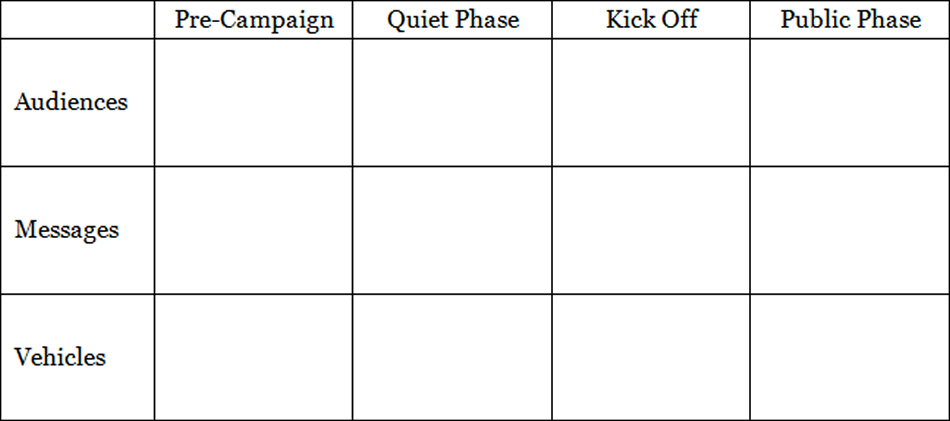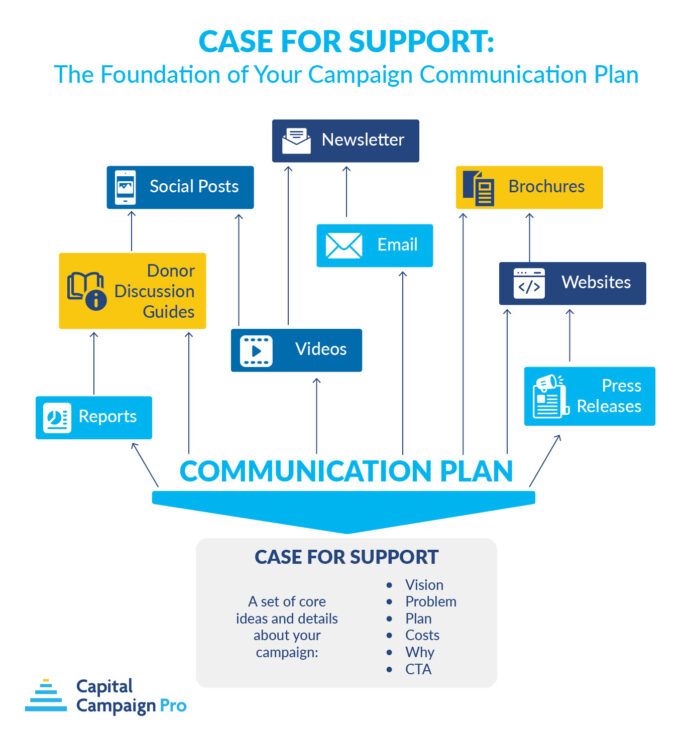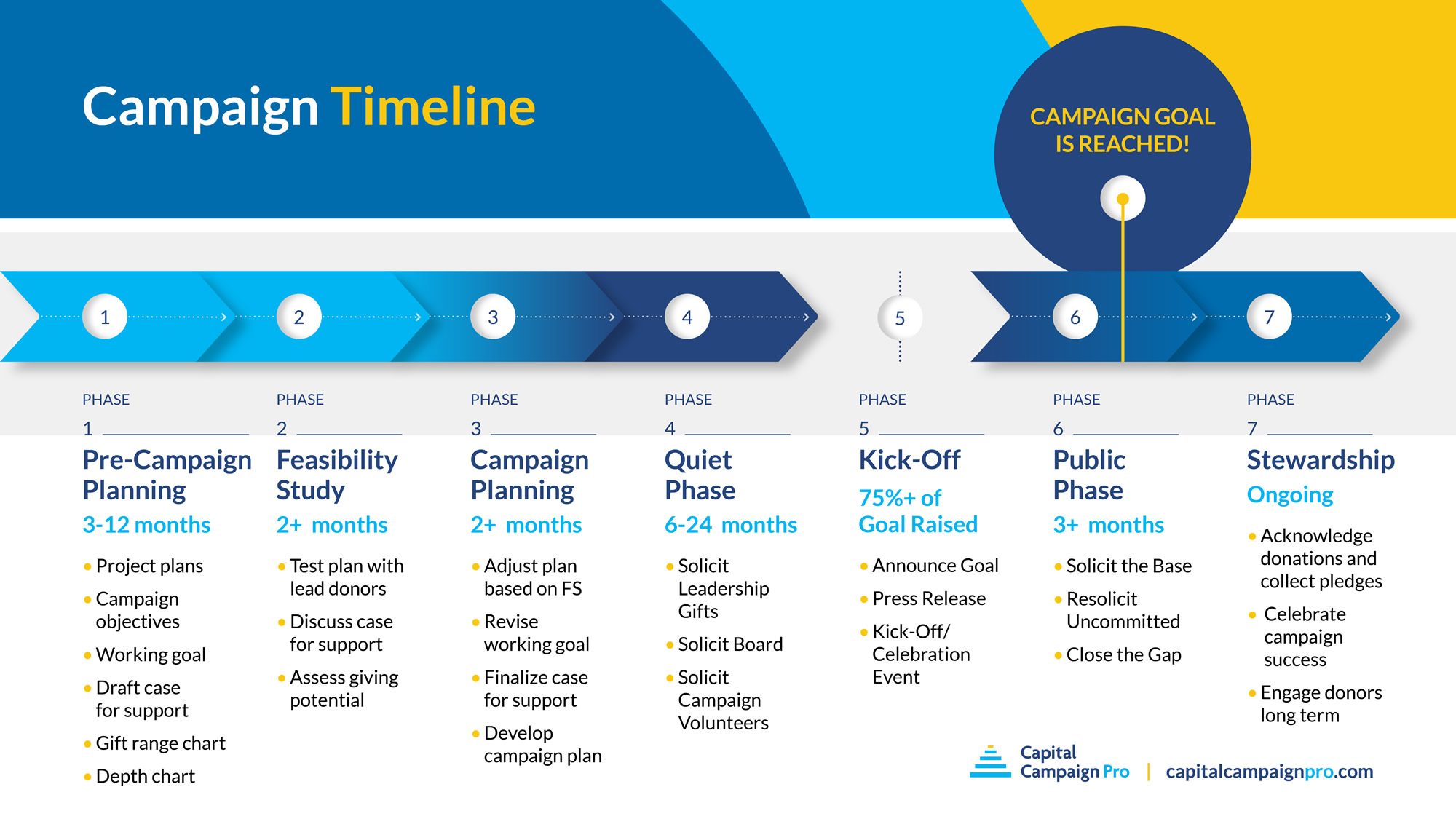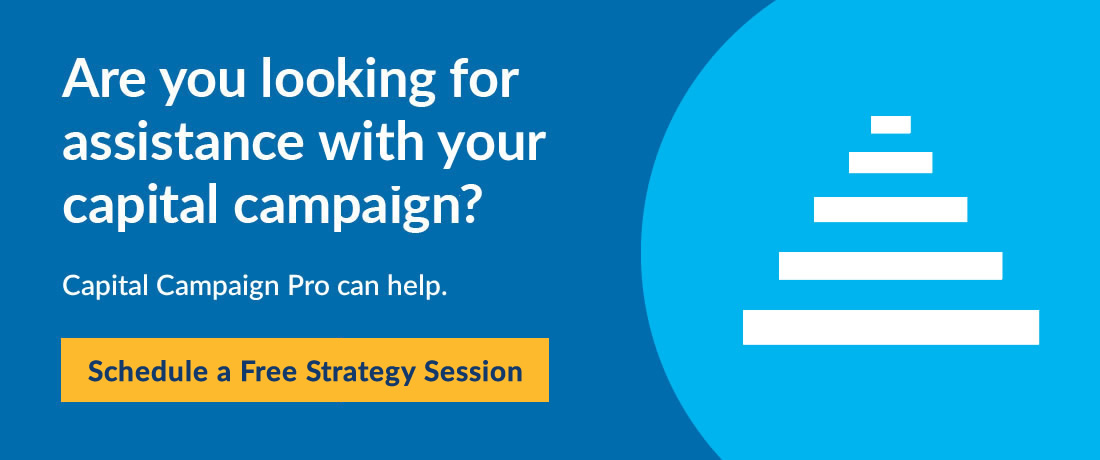Capital Campaign Case for Support: How to Write Your Own

One of the first things you need for your campaign is a case for support. Your case provides the foundation for crafting a complete campaign plan.
If you’re like most people, you probably think your case is essentially a glossy brochure. You may fervently hope that you can create a brochure so good that you can just send it to donors and they’ll be moved to write you a big check.
But that couldn’t be farther from the truth.
You’ll need a more complete communications plan that shifts throughout the phases of the campaign. And every element of that capital campaign communications plan starts with a clear and compelling case for support.
Quick Links — Use the links below to jump to each section of this guide:
- Case for Support: The Foundation of Capital Campaign Communications
- Writing a Capital Campaign Case for Support
- Capital Campaign Plan: Materials for a Comprehensive Communications Strategy
- Turning Your Case for Support into a Campaign Brochure
- The Importance of a Comprehensive Communications Plan
Already know you want hands-on guidance to develop your case for support?
Request your free strategy session today to chat with a fundraising expert.
Case for Support: The Foundation of Your Campaign Communications
What is a case for support?
Also known as a case statement, a case for support for a capital campaign is a clear and compelling set of ideas that literally make the case for why donors should give to your capital campaign. Though over the phases of the campaign, the way those ideas are expressed will shift and change, the key concepts will stay the same.
What to Include in Your Case for Support
Below you will find the eight sections of most effective cases for support:
- What’s the theme? The title of your case is one line that sets the tone and concept of what your campaign is planning to achieve.
- What’s the challenge? This section spells out the challenges your organization faces in carrying out its mission and highlights the impact the campaign will have on the community you serve. This section has to capture the attention of your donors in a compelling way.
- What’s the solution? This section describes what your organization is going to do to solve the challenges you face in a way that makes a donor what to help.
- Why your organization? In this section, you will describe why your organization is uniquely qualified for the task.
- Why now? You will convey a sense of urgency, outlining why the project should happen now.
- What will it cost? Describe here how much you will have to raise to make the project work financially and how you plan to raise those funds.
- Why does it matter? Reinforce the themes of your campaign in a way that will inspire donors.
- How can a donor help? Spell out how a donor can contribute to the campaign.
Writing a Capital Campaign Case for Support: 6 Key Elements and Examples
The best way to work on developing the case for support is by writing a simple draft word document that includes all of the elements above. Don’t include photos or fancy graphics. Just get the ideas right and written in a clear and simple style.
Your case for support doesn’t start out as a polished document. No one’s does. Your case should begin as a series of ideas organized in a logical and compelling way.
Once you’ve nailed down these essential elements, you can then weave them together into a compelling story. Connecting the dots with illustrative details about the purpose and impact of your campaign can go a long way to engage your donors—stories are remembered a whopping 22 times more easily than data and straight facts alone.
And while your organization’s campaign may be very different from any other organization’s, we’ve found that all truly compelling cases follow this simple 6-part framework.
1. Your Vision
Write two or three sentences describing your vision.
What difference will the money you raise make in the world? (Notice, I didn’t say, what difference will it make for your organization.) The vision is not about your organization’s needs. Your vision is about the difference your newly capitalized organization will make in the lives of others.
2. Your Problem
What’s keeping your organization from achieving your vision?
Describe what’s holding you back. This statement of the problem sets up the solution and your campaign.
3. Your Plan
How will you overcome the problem so you can achieve your vision?
Spell out simply what you plan to do with the money you raise and why that’ll solve the problem.
4. Your Costs
What’s your plan going to cost?
Summarize the elements of your campaign budget and add them up. The total cost will be your campaign’s working goal.
- 2nd floor Rent for 2-years: $85,000
- Cost of renovation: $110,000
- Computers and furnishings: $72,000
- Costs for expanded programing: $90,000 ($45,000 for each of two years.)
- Fundraising and administration: $55,000
5. Your “Why Now?”
Why is it important to solve the problem now? Every campaign needs a sense of urgency.
6. Your Call to Action
What can a donor do to help solve the problem and achieve the vision? How can they give and at what levels?
A call to action (CTA) explicitly lays out how prospective donors can get involved. For nonprofits, CTAs are all about urgency, clarity, and emotion. While you may hear this term used to describe buttons and other small snippets of text on websites, your call to action in a case for support will provide enough details to encourage a donor to act.
That’s it. Six elements that create a simple, logical and powerful flow.
Share the draft with other people and get feedback so you can see what works and what doesn’t. Then, rewrite it taking your feedback into consideration. It’s not unusual to write five or even ten drafts of this initial case for support.
The better and clearer and more compelling your draft gets, the more those ideas will serve as the basis for your entire campaign communications plan.
Is your Case for Support effective? Answer these 8 questions…
Here are eight questions to ask to see if your case for support is effective:
- Is your case defensible?
- Is your case both rational and emotional?
- Is your case optimistic?
- Is your case as brief as possible?
- Does your case make sound financial sense?
- Is your case easy to remember?
- Does your case call people to action?
- Is your case easy to read?
Capital Campaign Plan: Materials for a Comprehensive Communications Strategy
Communications for your campaign will shift for each phase of the campaign. The audiences will grow, the messages will change and the vehicles you use to communicate will take different forms. But the key ideas will all flow from the case for support.
You will find it helpful to create a grid like the one below that shows the audiences, messages and vehicles for each of four sections of your campaign.

In the Pre-Campaign phase, you will involve a small group of insiders and you will work with preliminary project plans, usually in draft form.
Through the Quiet phase of your campaign, you will solicit gifts from the donors with the greatest capacity and your board members. These conversations are usually most effective when you share essential information without slick presentations. You’ll need well-written and clean material to explain the project.
As your campaign gains steam, you’ll develop an e-newsletter to keep the group of insiders who have been involved up to date with the campaign’s progress. Email will be an important place to focus your attention throughout the campaign, as it remains one of the most effective communication channels available—21% of emails are opened within an hour of being sent!
And of course, by the time you kick off the campaign publicly, you’re going to need all sorts of other material.
As your campaign proceeds, you’ll find that the audiences, message and vehicles change. Until finally, by the end, you might be creating swag — hats, tee shirts, banners and more.
You will need a full range of campaign materials
To give you a running start on developing the communication plan for your campaign, here’s a list the material you are likely to need over the full range of your campaign.
- Letterhead
- Notecards
- Pledge forms
- Envelopes and labels
- Newsletters
- Brochure
- Campaign report
- Donor discussion guide
- Folders for donor material
- Website and webpages
- Video
- Email appeal tamplates
- E-newsletters
- Social media messages
- Swag (hats, buttons, banners, ads and more)
Download and save this handy list here »
Note: A communications plan comes before a brochure.
In the diagram below, you can see how the case for support serves as the foundation for the campaign’s communication plan. Only then can you distill your core messages and details into all the different brochures, emails, videos, and more that you’ll need throughout the campaign.

For example, your campaign volunteers may think that the first thing you need is a fancy campaign brochure. They may even push you to hire a design firm to develop one. But it’s much wiser to focus on a well-conceived communications plan first.
In fact, one of the best ways to keep volunteers from demanding a fancy campaign brochure well before you’re ready for one is to share your communications plan with them.
If you’d like to see a sample communication plan, check out the material in the Capital Campaign Pro toolkit. It’s got everything you need to guide you.
Turning Your Case for Support into a Campaign Brochure
You will need a campaign brochure in time for your campaign kick-off. Looking at the campaign timeline below, you can see that the kick-off marks the end of the quiet phase of the campaign. At that event, you will set the final dollar goal for your campaign — a goal you know you will be able to reach.

Your campaign brochure announces that final campaign goal and transforms the ideas you developed in your case for support into a well-designed brochure. Use images, headings, and color to breathe visual life into your case for support.
The primary purpose of your campaign brochure
The primary purpose of the brochure is to provide support and reassurance for the many volunteers who will solicit gifts for the campaign during the public phase.
In most campaigns, a few key staff members and volunteers will solicit the large gifts during the quiet phase. The people who solicit those large gifts are very familiar with the organization and the campaign and don’t need the support of a fancy brochure. In fact, most of the largest gifts for a campaign are raised with simple drafts of the case for support.
But when the campaign broadens into the public phase, a campaign brochure gives volunteers the confidence they need to ask for gifts.
Things to include in your campaign brochure
In addition to the key elements of your case for support, campaign brochures usually include these other items as well:
- Gift range chart showing how many gifts at each level you will need to reach your goal.
- A description of the various ways donors might give to the campaign.
- A list of the people serving on the campaign committee and the board of directors.
- The list of donor recognition opportunities.
- A message from the campaign chair or chairs.
The Importance of a Comprehensive Communications Plan
As you can see, the campaign brochure is just one of the communications pieces you will need throughout your campaign.
But most board members and campaign volunteers have little campaign experience. And to them, it may seem strange that you don’t need a fancy brochure when you approach the largest donors early in your campaign.
In fact, some people believe that all you need for a campaign is a glossy brochure.
It will take a bit of work to educate your board members about the way campaigns work. And having a well-developed campaign plan early in your campaign will help you thwart the inevitable cry to hire a designer to create a fancy brochure right up front.
Make sure you don’t let your organization fall into that trap. Instead, get key staff and board members to help develop the drafts of your case for support first. Then, outline a communications plan which spells out the messages, audiences and media for each phase of your campaign.
Once your board members see a clear communications plan and how it lines up with the phases of your campaign, they’ll be happy to get on the right path.
See the difference that an organized plan and expert guidance can make for capital campaigns of all sizes:
Have more questions or want one-on-one help crafting your case for support? Check out our comprehensive FAQ guide to capital campaigns or get in touch. We’ll be happy to help!










There is such practical advice here! Your content is a guidepost for a small campaign I’m part of as a board member. Today we are reviewing the draft campaign case for support and I’m bringing this article to help make sure we have checked all the boxes. Thank you!
Thanks for your comment, Dana. We always appreciate knowing that our posts have been helpful.